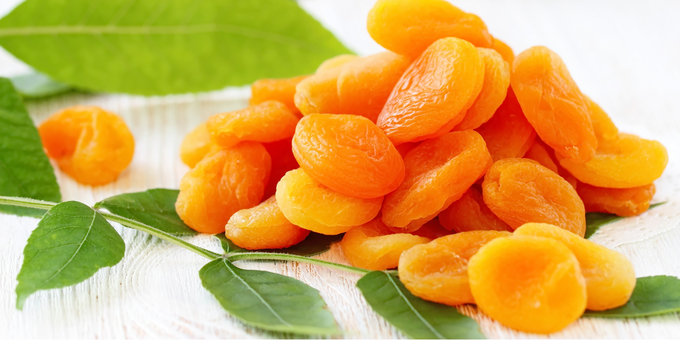Dried fruit sounds like a wholesome snack, right? Well, this is not quite the case – it turns out some pack upwards of triple the amount of sugar as their fresh counterparts. Read on to find out what you can do about it.
Dried fruits like apricots, apples and plums have a higher glycaemic index (GI), meaning they spike blood sugar levels. The result? Irritability, fatigue, headaches and the dreaded 3 o’clock slump. Take a look at a few more of the unpleasant signs of a blood sugar spike:
- Mood swings
- Tingling in hands and feet
- Blurry vision
- Increased thirst
- Increased hunger
High GI snacks are not ideal for maintaining stable blood sugars – and therefore stable energy, and excessive consumption of these foods can even lead to metabolic diseases like obesity and type 2 diabetes down the line. With dried dates coming in at a 62 GI rating, dried figs measuring in at 61 and the lunchbox-favourite raisins coming in at 59, these seemingly healthy snacks are not quite as innocent as they look – despite what the packaging would have us believe.
With rates of obesity having tripled since 1975 and studies proving excess sugar consumption to be one of the major contributors, what we put on our plates can make a big difference for our health – both long and short term. Aussies consume around 15 teaspoons of added sugar each day, more than doubling the 6-teaspoon recommendation. This becomes even more significant when considering the fact that excessive sugar intake, even if it comes from dried fruit and not a chocolate bar, leads to insulin resistance, which is the precursor to type 2 diabetes. To make matters worse, many dried fruit brands have sugars added to an already high-sugar product.
If you’ve decided it’s time to kick your sugar habit, we invite you to sign up to our 8-Week Program. It can be intimidating and confusing to quit sugar alone – especially in our sugar laden world where so-called health foods are packed with sugar. We’ll show you all the best techniques to manage the cravings and how to enjoy a delicious diet, minus the sugar crashes, of course. With simple, tasty recipes and support throughout the journey, there’s never been a better time to transform your health. JOIN NOW!
One of the biggest solutions for reducing your risk for disease – and even just preventing those afternoon slumps caused by unstable blood sugars – is to swap out those sugary dried fruits for some more nutritionally balanced alternatives.
We’ve collated a few low-sugar, high-energy snacks that will help you power through the day – with not a blood-sugar spike in sight!
Whole fruit.

Dried fruit may share the same origin as whole fruit, but it’s a far more concentrated version, meaning more sugar. Dried fruits tend to be made up of around 38 to 66% sugar. Yep – that’s a lot of sugar. While both whole and fried fruit are packed with fibre that helps to break down the fructose, dried fruits tend to tip the scale in the direction of excess. Fructose can be a tricky thing as our livers are solely responsible for metabolising it, and too much of it can lead to the development of visceral fat and non-alcoholic fatty liver disease – this affects around a quarter of the population, and sugar is one of the big culprits.
This is where fibre comes in. It slows the absorption of the sugars and helps the body make better use of the energy, thereby reducing sugar spikes and promoting a healthier liver. But with dried fruits knocking their fresh counterparts out of the water for sugar content, reducing our intake is a good step to keeping the strain off our livers. While any whole fruit makes for a great snack, some great low GI options include grapefruit, dragon fruit and apples.
Nuts.

The nutrients in nuts play an important role in maintaining energy, satiety and curbing sugar cravings. For example, peanuts are packed with healthy fats – the cholesterol-lowering and metabolism-balancing kind. The vitamins and minerals in nuts also make them a nutritional snack option – minus the sugar that comes with dried fruit. Nuts provide magnesium, iron, biotin and even calcium – with pistachios providing 14% of our daily needs of the latter in just one cup. Biotin is also an important nutrient due to its healthful properties, which can help with the following:
- A healthy metabolism
- Blood sugar stabilisation
- Reducing inflammation
- Brain function
Chickpeas.

Providing nearly a third of our daily protein needs and 15% of our calcium needs, chickpeas are a top-tier snack option. But research also shows they benefit digestion and gut health, and with their slow-release energy, they’ll keep you fuller for longer and balance your blood sugars.
For a lunchbox or office-worthy snack, simply pop some chickpeas into the oven with a dash of olive oil and paprika, and there you have a nutritious, low-sugar snack. Other legumes like lentils and beans also make for a low-GI snack, though the nutritional profile and taste of chickpeas are a winner when it comes to snacking.
We know how hard it can be to fight intense sugar cravings and that’s why we’re hosting the 8-Week Program. With meal plans, shopping lists and ongoing support, you won’t have to face it alone.
If you’re ready to transform your health and take your wellbeing into your own hands, sign up HERE.






Leave a comment (all fields required)